This post is written by Helen Breewood, research and communications officer at the FCRN. She blogs about global sustainability issues at The Progress Motive. You can find her on Twitter. She is writing this post in her personal capacity.
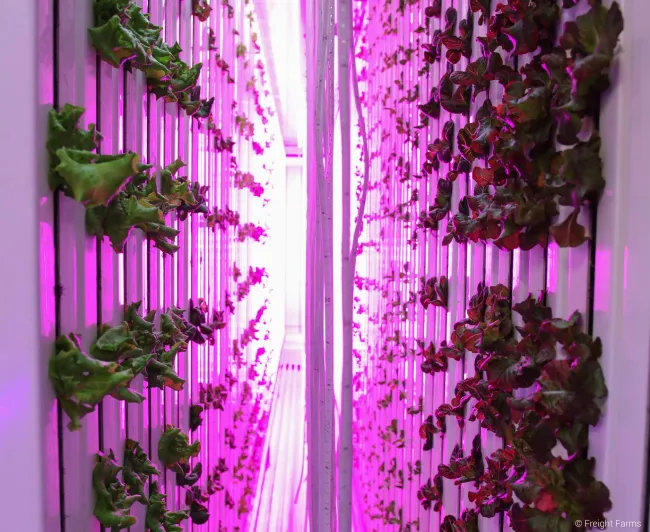
Cover image: LED lights, Freight Farms Press Kit
Should food be grown in cities? If so, how? These questions have a long history, with the last few hundred years taking in the Garden City movement where towns were designed to include homes, industry and agriculture, the ‘Victory Gardens’ of the First and Second World Wars and, more recently, the food miles debate.
Meanwhile, futuristic visions of the food system often feature city-centre skyscrapers full of fresh fruit and vegetables, carefully tended by a fleet of robots, with precise doses of fertiliser, water and exactly the right wavelengths of light administered by an intelligent computer – and perhaps open to city dwellers looking to unwind among some greenery or learn how their food is produced. Entrepreneurs Peter Diamandis and Steven Kotler, for example, paint a rosy picture in their book Abundance, in which they claim that just 150 thirty-storey farms could feed the whole city of New York.
But look closer, and the picture becomes less clear. Isn’t urban farming an old tradition, in the form of allotments or community gardens? Aren’t commercial greenhouses already highly automated? Is it really more efficient to build a huge structure and use artificial lights, instead of just transporting food from farmland using rapid modern supply chains? If high-tech skyscraper farms are really more efficient (in terms of resource use or environmental impacts per unit of output) than field-based farming, why limit them to urban areas where land is expensive?
This purpose of this blog post is to disentangle some of the many intertwined concepts here: urban, indoor and vertical farming. The diagram below is one attempt at showing how several different forms of food production can be classified as urban, indoor, vertical or a combination. I’ll outline some of the main factors and questions surrounding their implementation. This post does not aim to answer all the questions raised, nor make a judgement on which types of urban, vertical or indoor farming are ‘best’ or most sustainable. Its purpose rather is to stimulate ideas and discussion among FCRN members. Do give your thoughts and feedback via the FCRN Google Group.
This post focuses mostly on high-tech farming rather than, say, allotments. It also focuses on higher-income countries. However, urban farming is of great importance in the context of lower-income countries – see, for example, the paper Sustainable urban agriculture in developing countries. A review and the work of the RUAF Foundation, which is a “global partnership on sustainable urban Agriculture and Food Systems”. For more information on different aspects of urban, indoor and vertical farming, see the resources list at the end of this post.

Image: one possible way of classifying agriculture according to whether it is urban, indoor, vertical or a combination of these. An alternative visualisation of these categories could be a 3D graph with three axes: rural to urban, outdoor to indoor, and horizontal to vertical. In this latter option, individual items could be placed at the appropriate point along each axis, instead of being classified as strictly urban or rural (say).
Urban agriculture
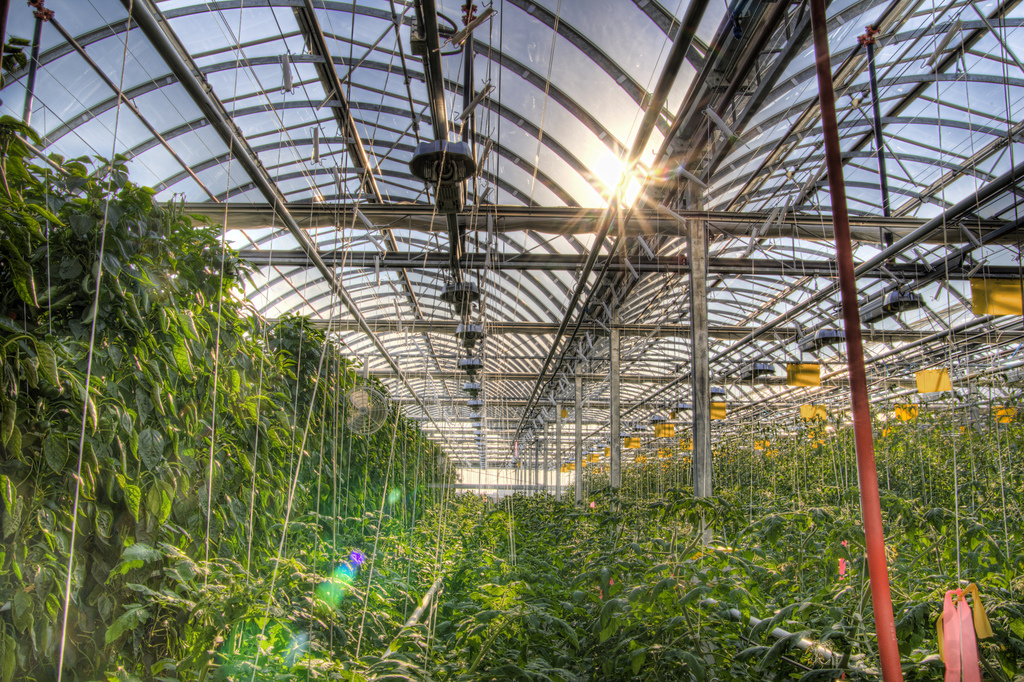
 Image: Fadi Hage, Greenhouses at Lufa Farms, the world’s first commercial rooftop greenhouses. Montreal neighborhood of Ahuntsic-Cartierville. Wikimedia Commons, CC BY-SA 3.0
Image: Fadi Hage, Greenhouses at Lufa Farms, the world’s first commercial rooftop greenhouses. Montreal neighborhood of Ahuntsic-Cartierville. Wikimedia Commons, CC BY-SA 3.0
The location of agriculture can be defined on a spectrum from rural to urban, with urban or semi-urban encompassing a wide variety of situations such as windowsills, allotments, private gardens, public parks, multi-storey farms, industrial estates, rooftop gardens and even disused underground rail tunnels or ‘guerrilla gardens’ (areas of land that people cultivate without having formal legal rights to do so, such as unused building sites).
Proponents of urban agriculture claim that it has both environmental and social benefits.
On the environmental side, these include lower transport emissions, introducing green areas and biodiversity into cities, food waste reductions, greater efficiency of water use, and greater ease of using urban waste streams as a farming resource or linking with renewable energy production.
On the social side, listed benefits include fresher food, community cohesion, stress relief and mental health improvements, training and employment opportunities, and increased access to fresh fruits and vegetables. Matt Barnard, CEO of hydroponics startup Plenty argues that fruit and vegetables can be made cheaper by cutting out transport costs – and that therefore more people might be able to afford to buy them.
However, not all these benefits have a strong evidence base, not all apply to all types of urban agriculture, and there are also potential disadvantages to consider.
An example of a benefit that only applies to a specific form of urban agriculture is aesthetics. Anna Birgitte Milford, Research Scientist in the Division of Food Production and Society at NIBIO, is currently studying rooftop greenhouses in Bergen, Norway. She argues “A rooftop greenhouse can also, if done well, become an aesthetic landmark in any city, and this has a lot of social value.” However, commercial urban farms might not be open or visible to the public – and, as Milford points out, the aesthetic aims of a greenhouse may conflict with achieving optimal plant growing conditions. Mike Hamm, who is C.S. Mott Professor of Sustainable Agriculture at the Centre for Regional Food Systems, Michigan State University, adds that while one of the arguments used to promote some urban farms is that organic agriculture would be easier because pests can be excluded, this attribute would be absent in the case of open green spaces.
Similarly, while employment opportunities may be created by some types of urban farming, highly automated urban farms may not create many jobs. Nevertheless, social enterprises can be designed specifically to provide educational opportunities, access to green space or other social benefits (see for example the box below about Gorgie City Farm).
There could be trade-offs between emissions savings from transport reduction and the high energy or material use of some forms of urban agriculture (for more on the resources used by indoor agriculture, see below).
According to Milford, it is difficult for rooftop greenhouses to be economically viable because of the additional material cost required to safely construct rooftop greenhouses and because of the higher costs of urban compared to rural land. However, successful examples do exist: Lufa Farms, which operates commercial rooftop greenhouses in Québec, claims to be running a profitable business.
While Hanna Tuomisto, Associate Professor at the University of Helsinki, says that freshness is one possible advantage of urban agriculture (indeed, many urban agriculture companies focus on freshness as a selling point, including Plenty, Lufa Farms and Farm.One), freshness is only important for some types of crops, such as salad leaves and soft fruit. There will almost certainly be little advantage in growing less perishable crops, such as grains, in urban locations.
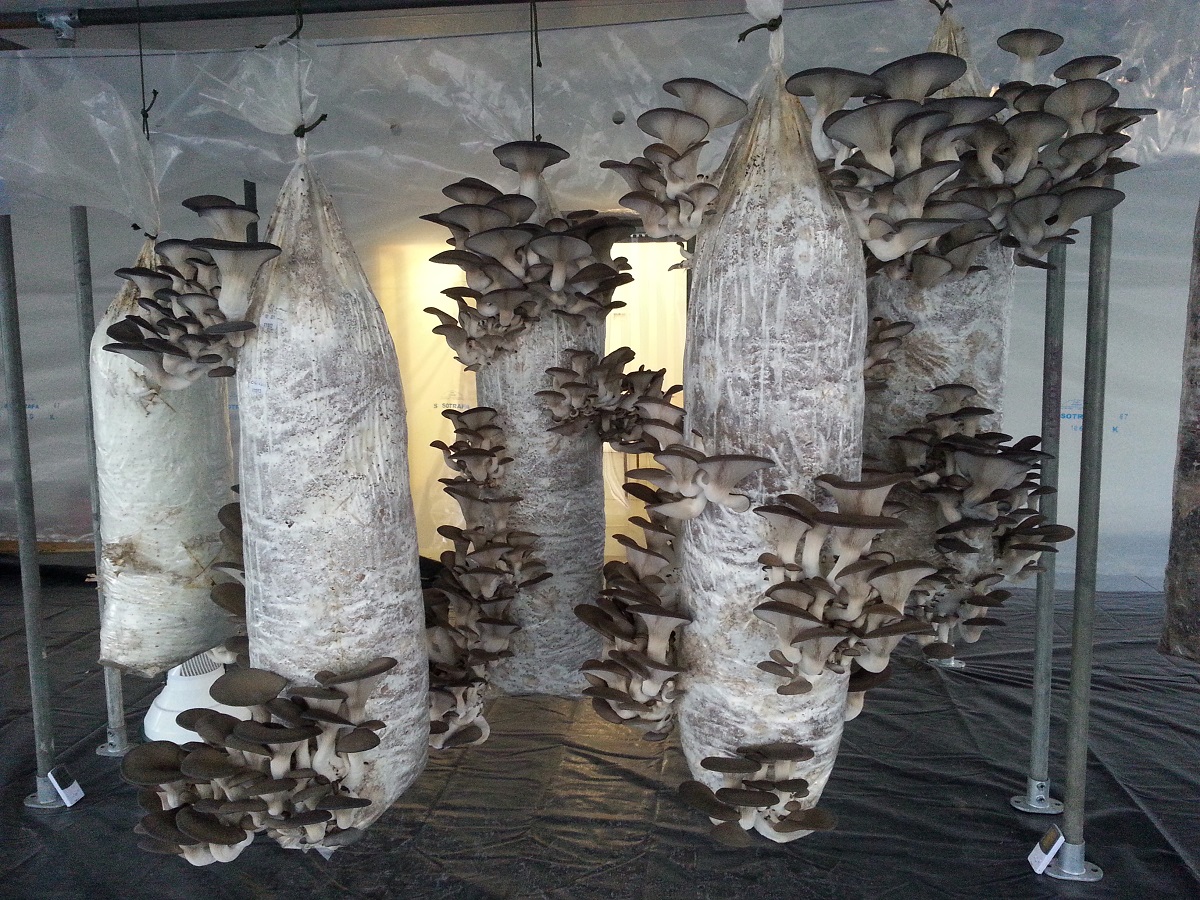
 Image: GroCycle Urban Mushroom Farm, Grocycle press kit
Image: GroCycle Urban Mushroom Farm, Grocycle press kit
According to Peter Wootton-Beard, Lecturer in Agri-Technology at Aberystwyth University, another advantage of urban farming is that it becomes easier to use so-called ‘co-located’ resources or waste streams as inputs for the farm, including “nutrient recycling technologies such as anaerobic digestion, insect production, micro algae production (both for protein) and the use of waste heat and CO2 from CHP [combined heat and power] plants or electricity generation.” Thinking along similar lines, Diamandis and Kotler have suggested that the energy to run artificially-lit urban farms could be extracted from sewage, a waste stream that is readily available in urban areas. Another enterprise taking advantage of urban resource streams is GroCycle, which uses waste coffee grounds from cafes as a substrate to grow mushrooms in a disused office building. It would be less practical to transport the coffee grounds to a rural area, because they go mouldy quickly.
Gorgie City Farm: an example of urban agricultureImage
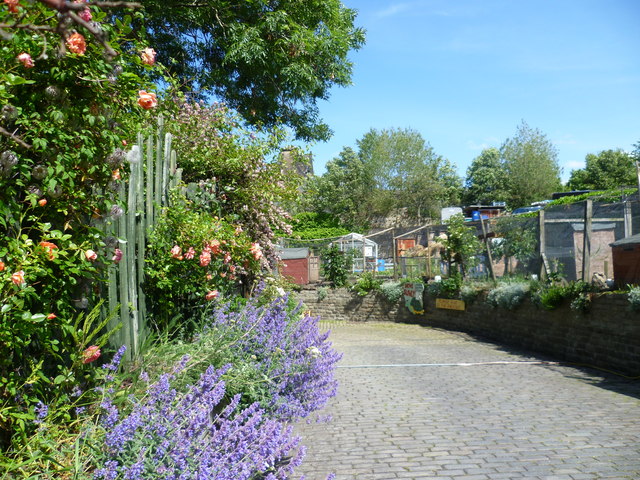
Image: Kim Traynor, Gorgie City Farm, Geograph, Creative Commons Attribution-ShareAlike 2.0 Generic Gorgie City Farm in Edinburgh, UK, is an urban farm designed to promote education, volunteering opportunities and social inclusion. It offers free entry to visitors along with educational tours and workshops. As well as selling fruit and vegetables to local shops and restaurants, the farm showcases traditional animal farming methods. The farm is a charity and accepts donations rather than being economically self-sustaining through food production. |
Indoor agriculture

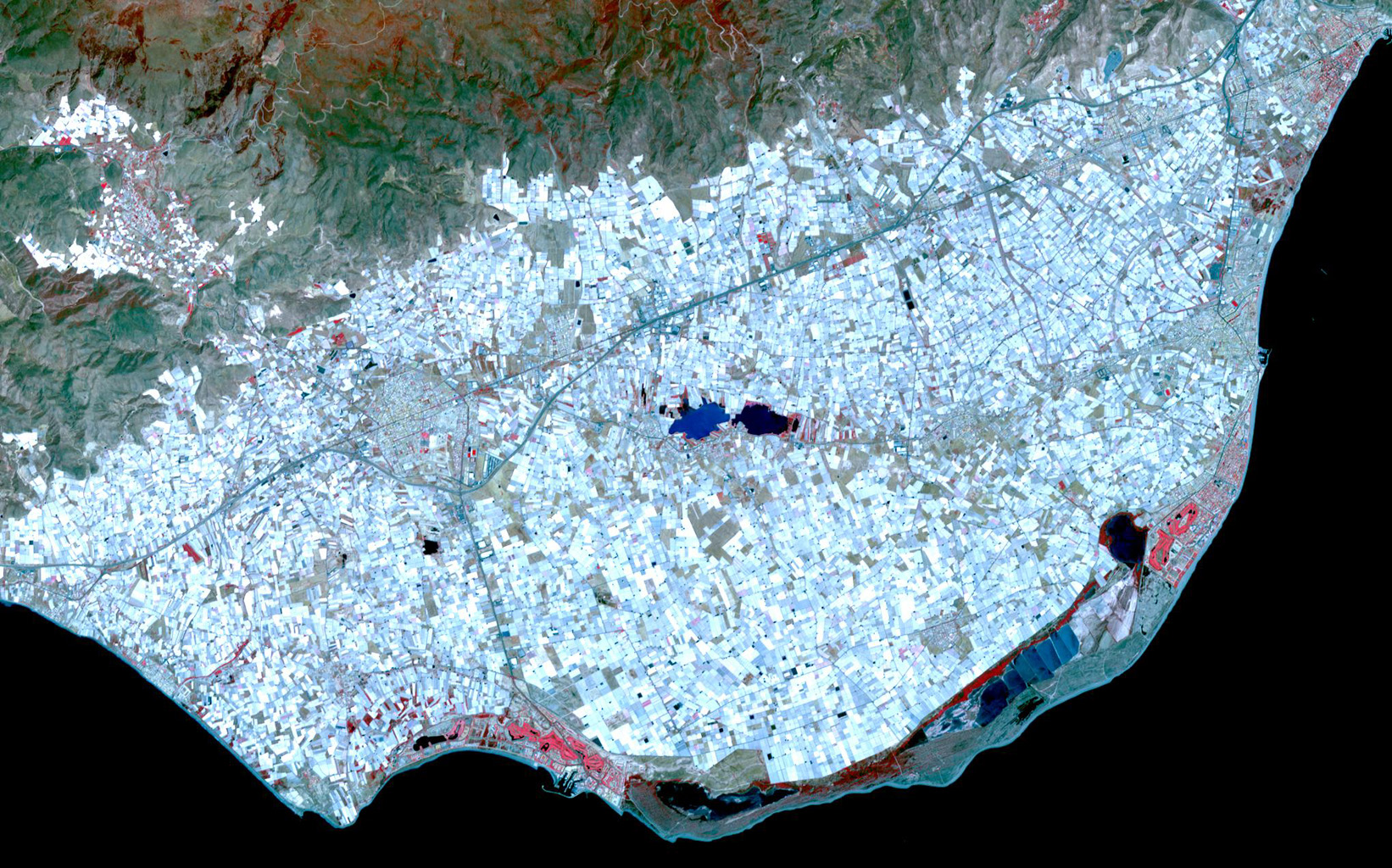
Image: NASA/GSFC/METI/ERSDAC/JAROS, and U.S./Japan ASTER Science Team, Surrounding the town of El Ejido, Almeria Province, southern Spain is a sea of greenhouses, stretching for tens of kilometres, NASA image policy
Indoor farming encompasses a range of food production methods such as cold frames, polytunnels, unheated greenhouses, heated greenhouses and so-called controlled environment agriculture (CEA), with tight control over many aspects of the growing environment (e.g. LED lighting with tuneable wavelengths to replace or supplement sunlight). What these methods have in common is a greater ability to control the growing environment than with outdoor production.
Some claimed advantages of indoor farming include better working conditions (e.g. less heat stress compared to working outdoors), greater control over pests and diseases, improved food safety, less vulnerability to extreme weather, the ability to produce all year long, lower emissions of pollutants such as excess nutrients and pesticides to the air, soil or waterways, and the ability to fine-tune crop flavours by adjusting growing conditions.
However, the energy and resource use of indoor farming can be high, depending on climate. For example, it takes so much energy to heat greenhouses in France that tomatoes grown in them have a higher carbon footprint than imported tomatoes grown in unheated greenhouses in Morocco, even after accounting for transport (Payen et al., 2015).
Speaking of relatively high-tech indoor systems, Mark Bomford, who is Director of the Yale Sustainable Food Programme, says “CEA comes at a higher energy cost per unit than field production for the same thing, which in most analyses means a higher environmental cost”, citing the thesis of Yoshihiko Wada, who in 1993 used real-world data to calculate the environmental impacts of tomato production in comparable hydroponic systems with conventional open-air farming. According to Bomford, Wada found that “sustaining the production of 1t tomatoes in a high-yield CEA system would actually require 15 times the ‘ecological footprint’ land for the same 1t of tomatoes in a low-yield field system [emphasis added]”. Bomford has advised several CEA startups, and mentions that these startups have generally viewed the high environmental impacts of CEA as a challenge to be overcome through greater efficiency.
Bomford does think that CEA has some advantages – namely, making working conditions safer and employment more seasonally stable – but suggests CEA may be best suited to single-storey sun-lit systems on relatively cheap rural land, and that multi-storey CEA farms on expensive urban land – i.e. the popular futuristic skyscraper farm vision – may be limited to a small market niche. Hamm agrees.
The relative ease of automation in indoor systems raises questions over control and ownership of technology and knowledge. For example, Infarm remotely controls all of its growing units (see box below). Although cofounder Erez Galonska says that the system will “re-empower the people to take ownership of their food”, might it actually mean that growers no longer develop expertise in recognising and responding to a plant’s needs? Plenty won’t share details of its hydroponics technology (source), but Liverpool’s Farm Urban, in contrast, gives out free instructions for building mini aquaculture kits.
Infarm: an example of indoor farmingImage
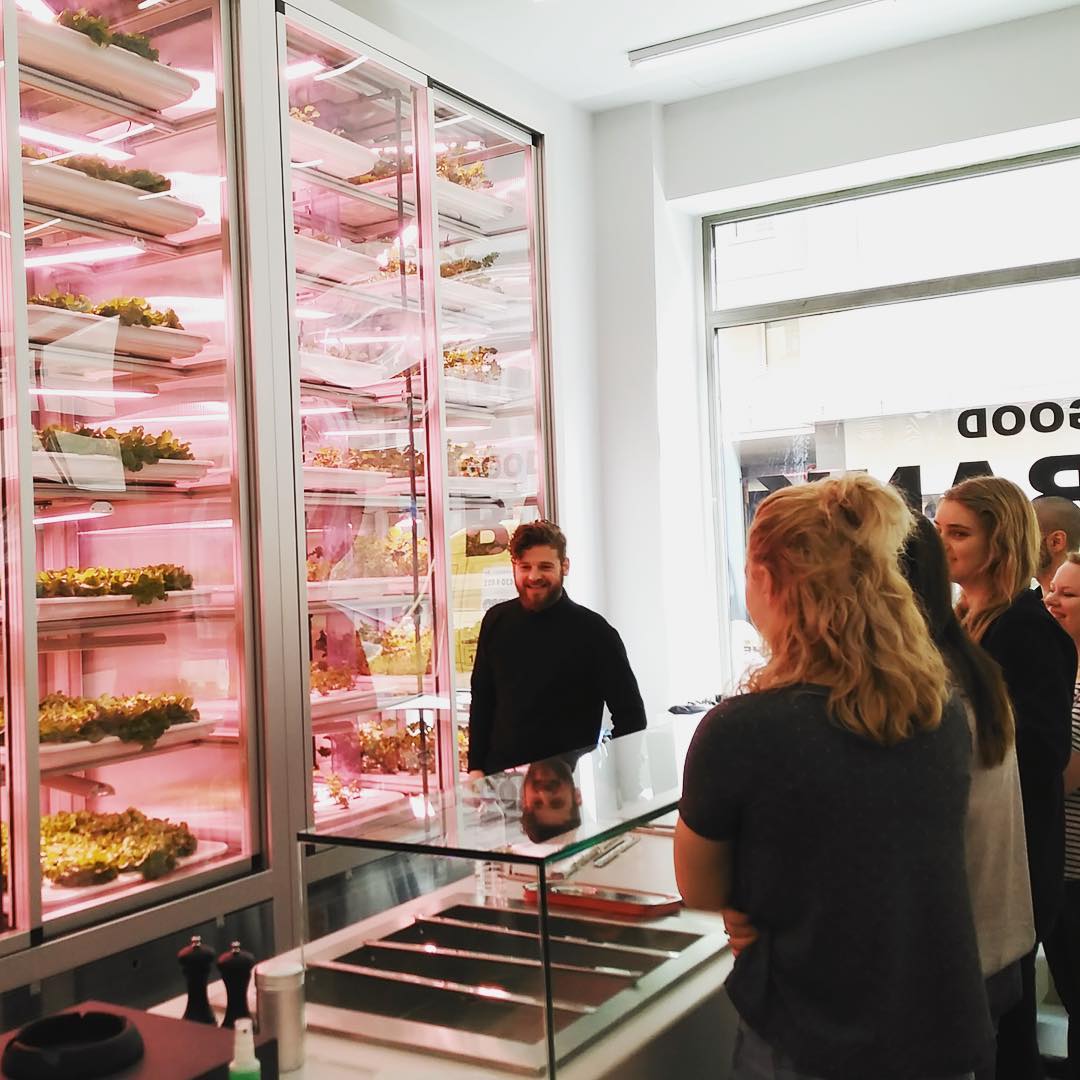
Image: Infarm, First vertical farm to table restaurant opens its doors, Instagram, Permission for re-use given Berlin-based startup Infarm makes modular, automated farming systems that are designed to be used in locations close to consumers, such as supermarkets, restaurants, bars and schools. Infarm happens to be not just indoor but also vertical and – generally – urban. The systems are remotely run by Infarm’s central control system to provide the right light spectrum, temperature, pH and nutrient levels for the crops. Retailers and others who hire the growing units won’t have to control the units themselves, other than to harvest the produce. Infarm claims that one in-store farming unit is equivalent to 250 m2 of farmland (presumably in terms of production capacity) but uses 95% less water, 75% less fertiliser and no pesticide. It isn’t clear how Infarm’s carbon footprint or energy use compare to field-based farming. |
There are also economic implications if the demand for manual labour decreases through automation. While it may benefit farmers in some circumstances – for instance, some UK farmers are concerned that there may be a labour shortage under the UK’s proposed post-Brexit immigration system – might automation also put people out of jobs or contribute to the concentration of wealth in the hands of those who own the technology?
Wootton-Beard says that indoor farming “means the possibility of near complete control over the environment, opening up the possibility to tailor the environment to alter flavour, nutritional profile and other characteristics of food plants.” However, such a tightly controlled growing environment may imply strict biosecurity and hygiene measures and a lack of public access – which would preclude some of the social benefits cited by promoters of urban and indoor farming. Wootton-Beard notes the discrepancy between public perceptions and what might realistically happen, saying people “have seen the concepts for urban skyscrapers and food production integrated with living accommodation, which whilst not impossible, is much less economically viable [than] a factory style production line approach.”
Another question is reliability: while Wootton-Beard points out that indoor farming is “agnostic of climate change, political instability, trade deals, and supply chain complexities”, might high-tech indoor systems instead be vulnerable to failure through mechanical breakdown, electronic faults, or malicious hacking of the control systems? Are these risks higher or lower than the risks of pests and extreme weather in outdoor systems?
Some indoor farming businesses say that fewer pollutants are released to the environment, compared to outdoor systems. For example, hydroponics startup Plenty says its system means “absolutely zero pesticides going into the soil, groundwater, and your food.” However, Bomford suggests that comparing controlled environment agriculture (CEA) to conventional farming is “not really fair” unless the same crops are being compared, saying “Advocates of CEA often miss their targets in their marketing material, pointing to the environmental abuses of agricultural sectors that will never be viable indoors (i.e. they might invoke the ‘dead zone’ in the gulf of Mexico, despite the fact that CEA tech will not change corn and soy practices, or invoke the subsidence of land in California due to groundwater removals, despite the fact that CEA tech will not change tree nut, cotton, or alfalfa growing practices) and then present a solution for a completely different sector – generally niche specialty crops.”
Vertical agriculture
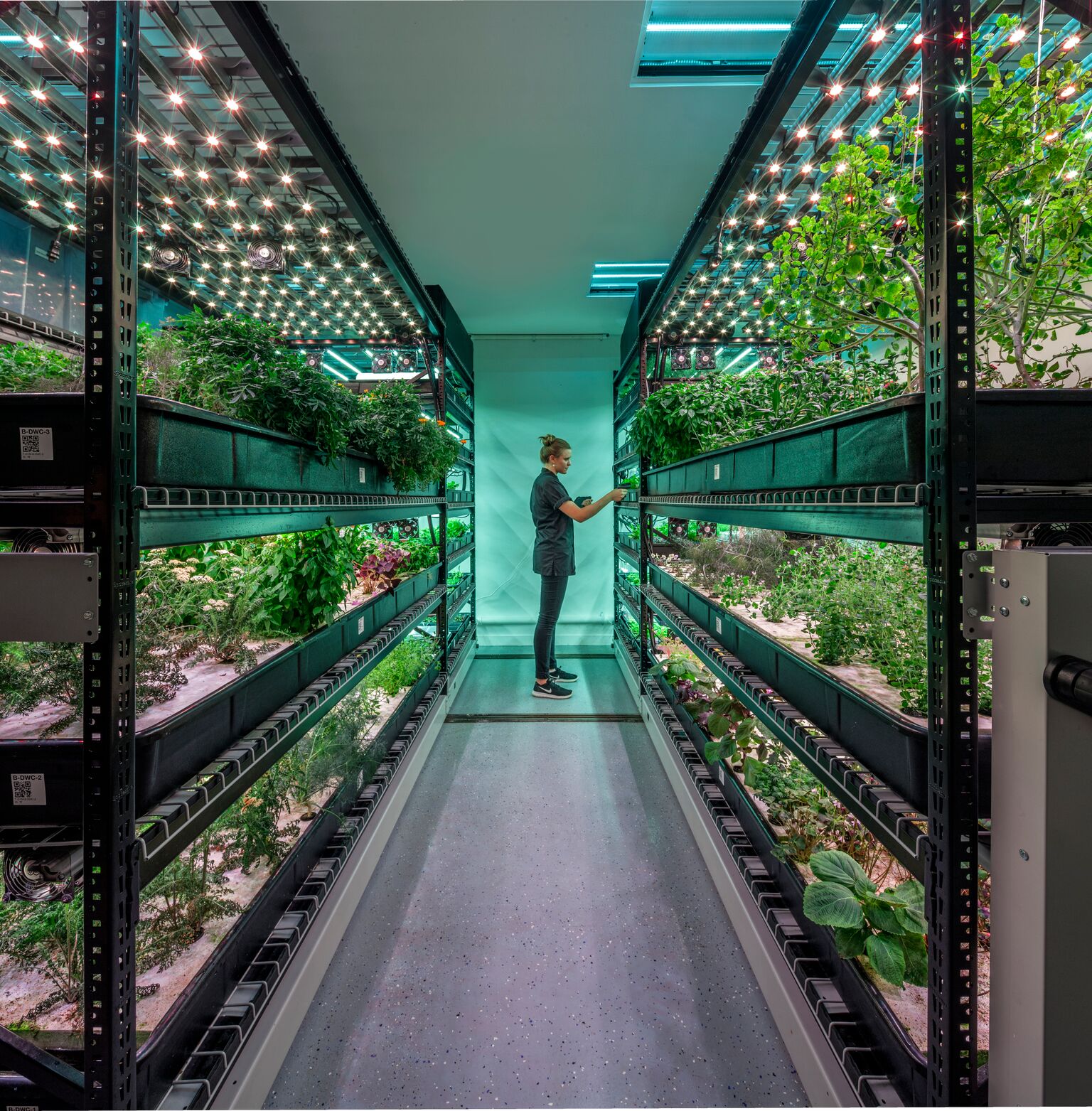
 Image: Farm.One press kit
Image: Farm.One press kit
Vertical farming can refer both to multi-level farms where the plants grow on stacked shelves of horizontal substrates, and to systems where the growth substrate itself is vertical, as in the Leafy Green Machine™, a ‘farm in a box’ where vertical strips of plants hang under artificial light in a converted shipping container (see the box below for more information). ‘Green walls’ of plants are also used for decoration, air purification, cooling of buildings or reducing stress, and less commonly for food production (e.g. the Edible Walls exhibit at Sydney’s Powerhouse Museum, curated by FCRN member Judith Friedlander). Vertical farming is highly compatible with growing techniques such as hydroponics, aquaponics and aeroponics, which don’t need soil.
One significant benefit of vertical farming is space-saving, relative to conventional ‘horizontal’ farming. This is particularly useful in urban areas, where land is more expensive than in rural areas. Vertical farming therefore offers the possibility of providing very fresh food by squeezing into urban locations near consumers – albeit perhaps at a premium, due to the energy use and high land costs. Perhaps vertical farming could compensate for some farmland lost to urbanisation. However, Tuomisto points out that some people are concerned “whether the plants from hydroponics have the same nutritional value [as] plants grown on soil.” For further discussion of this question, see this piece from the New York Times: Are Hydroponic Vegetables as Nutritious as Those Grown in Soil?
On the other hand, perhaps urban land would be better used to provide housing to reduce emissions from commuting – particularly since urban land is expensive compared to rural land. Furthermore, the space-savings benefits of vertical farming could also be applied in non-urban settings, such as growing food in cargo ships which would otherwise be empty on their return journey.
As Tuomisto tells me, vertical farming generally requires artificial lighting because otherwise the lower layers of plants would not receive enough sunlight. For this reason, vertical farming systems also tend to be indoor systems (although outdoor multi-level cropping systems could conceivably be classified as a form of vertical farming). Artificial lights, together with cooling systems to remove the heat they produce, require a lot of energy. Tuomisto says generating this energy sustainably may be a challenge, but adds that vertical farming systems may become more efficient in future through optimisation of lighting, cooling and fertiliser and water usage. However, Hamm suggests that gains in energy efficiency can’t beat using sunlight.
The cooling requirements of vertical farms are a contrast to horizontal heated greenhouses. In the latter, the relatively large ratio of surface area to volume means that a lot of light can get in, but that heat is lost rapidly (at least in a cold climate).
Perhaps there is an optimum shape of vertical greenhouse (maybe with only a few layers) where the heat produced by both natural and artificial lighting is approximately balanced by the greenhouse’s passive rate of heat loss. Such a greenhouse might need relatively little additional heating or cooling.
Tuomisto also cites high material costs as a disadvantage of vertical farming, raising questions as to whether vertical farming provides environmental benefits (see below for a discussion of the carbon footprint of one vertical farming system). We may have some answers soon, as Tuomisto is in the early stages of conducting a Life Cycle Assessment study of a four-layer hydroponic system in Finland. As well as considering the direct environmental impacts of novel farming systems, we should also consider interactions with the wider food system. For example, might land spared by vertical farming become available for carbon sequestration, e.g. through reforesting or BECCS?
Freight Farms: an example of vertical farmingImage
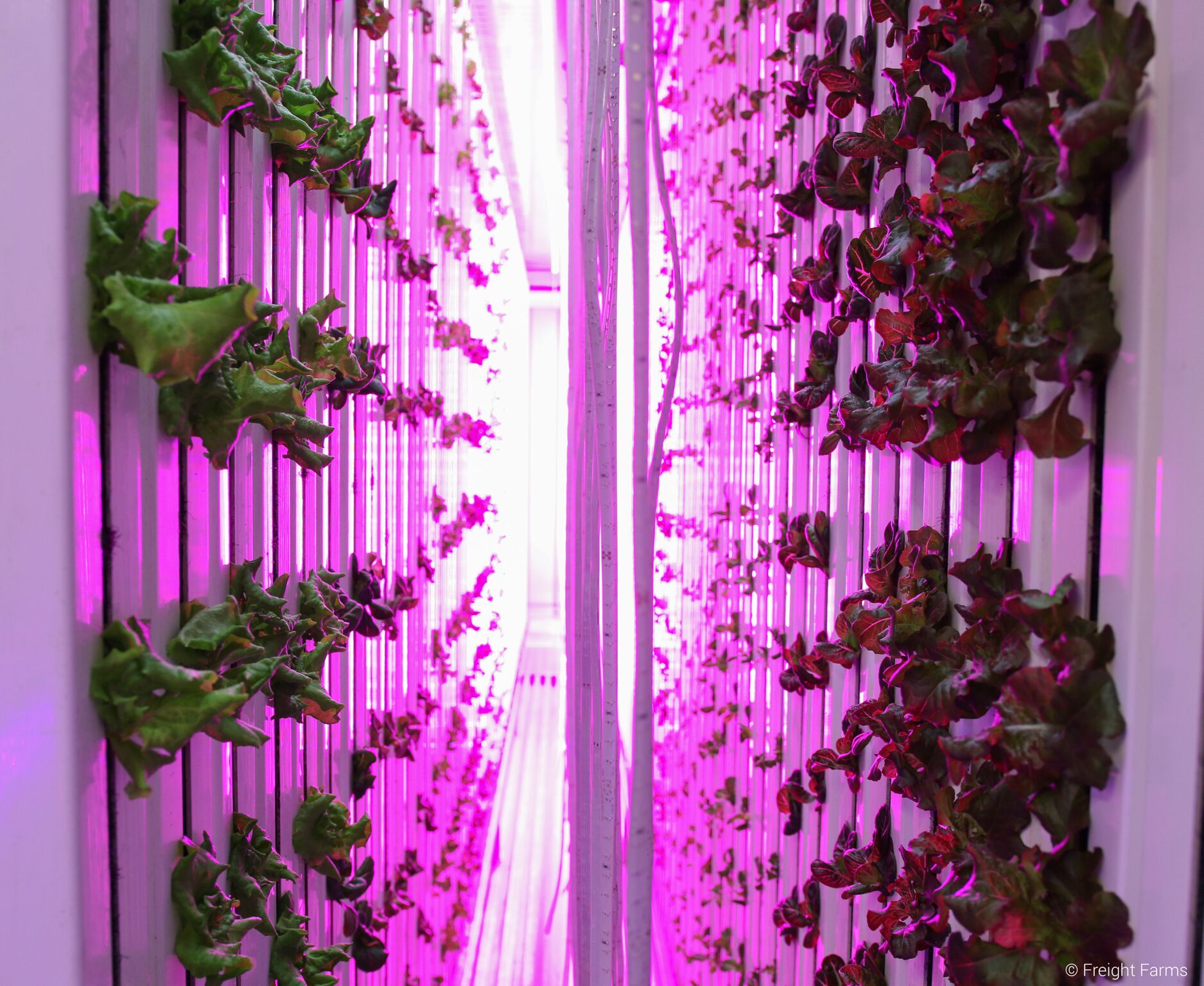
Image: LED lights, Freight Farms Press Kit The Leafy Green Machine™ (LGM) produced by Freight Farms is a vertical hydroponic growing system inside a shipping container. It has been used in urban areas such as Paris and Oslo and has also been placed on some conventional rural farms, where it adds the ability to grow herbs and salads all year round. Freight Farms claims that its system, which has an area of around 30 m2, can produce as much food in one year as two acres of farmland (it isn’t clear whether this is measured by weight) and uses 90% less water use compared to conventional agriculture. The system costs $85,000 to buy and around $13,000 per year to run (including electricity, water and growing supplies), according to Freight Farms. Freight Farms gives some illustrative figures for inputs and outputs, although these vary according to the outside climate: per week, 875 kWh of electricity, 160 litres of water, 15-20 hours of labour and $75 worth of nutrients can produce (for example) 52 kg of butterhead lettuce or 23 kg of spinach. Freight Farms doesn’t give the carbon footprint of growing food with the LGM. However, if as a very rough estimate we take a carbon intensity of 414 g CO2 eq. per kWh of electricity (the UK’s electricity mix on 3 January 2019, according to Electricity Map), then the electricity to run the Leafy Green Machine™ for a week would cause emissions of roughly 362 kg CO2 eq. That’s around 7 kg CO2 eq. per kg of lettuce, or nearly 16 kg CO2 eq. per kg of spinach – only accounting for electricity, not fertiliser, water or construction of the LGM. How does that compare to conventional production? According to Clune et al., who reviewed the carbon footprints of food production across the world, typical carbon footprints are 3.70 kg CO2 per kg of lettuce (based on heated greenhouse production) and only 0.54 kg CO2 eq. per kg of spinach. That means food produced in the LGM has a carbon footprint at least 2 to 30 times higher than for conventional production, not accounting for transport. Does reduced transport compensate for the increased carbon footprint of growing food in an LGM? It seems unlikely: transporting food across several thousand kilometres might only produce around 0.7 kg CO2 eq. per kg of lettuce, according to Mike Hamm. Of course, if the LGM were to be used with lower-carbon electricity, the carbon footprint of the food produced would fall. In France, for instance, where the large contribution of nuclear power means the electricity mix produces only 74 g CO2 eq. per kWh (3 January 2019, Electricity Map), the LGM carbon footprints would fall to (as a minimum) 1.2 kg CO2 eq. per kg of lettuce and 2.8 kg CO2 per kg of spinach – which, for spinach, is still much higher than conventional production. The LGM may have some advantages, but climate impact is not necessarily one of them. |
In conclusion
There is a great deal of enthusiasm for new forms of farming. Milford even tells me “I have probably never been met with more enthusiasm when searching for stakeholders to a project.” However, perceptions are not always realistic. Wootton-Beard says “I have found that people tend to be orientated towards the utopian visions for indoor farming, and imagine it to be some sort of science fiction strangeness”, while Bomford claims “Public perception of CEA often seems a fantastical construction.”
Urban, indoor and vertical farming encompass a wide variety of systems, each of which have different benefits and drawbacks. Perhaps many of the systems considered here do have some role to play in our future food system, with each type being suited to serving different environmental, social or economic goals.
Acknowledgements
Many thanks to our interviewees and to other FCRN members who have helped to produce this blog post by pointing out useful resources, including Anna Birgitte Milford, Hanna Tuomisto, Peter Wootton-Beard, Mark Bomford, Mike Hamm, Judith Friedlander, Annie Leymarie, Steve Gillman and Angelika von Heimendahl.
Resource list
There is a lot of existing work on the environmental, social and economic dimensions of urban, indoor and vertical farming. Here are some resources you may find useful. Please note that inclusion of an item on this list doesn’t imply endorsement, and that this list is far from exhaustive.
Organisations
RUAF Global Partnership on Sustainable Urban Agriculture and Food Systems
Association for Vertical Farming
SHARECITY – Sustainability of city-based food sharing
Research papers and reports
Sustainable urban agriculture in developing countries. A review – identifies the major roles and challenges associated with urban agriculture in lower-income countries.
Consolidating the current knowledge on urban agriculture in productive urban food systems: Learnings, gaps and outlook – reviews the possibilities for the future development of urban agriculture, particularly focusing on scaling of logistics, economic performance and business models, and institutional and civil development.
Environmental Impacts of Urban Hydroponics in Europe: A Case Study in Lyon – Life Cycle Assessment of a vertical hydroponics system in France; finds that electricity source is a key factor in determining whether hydroponics can out-perform conventional heated greenhouses or open-field agriculture.
A Global Geospatial Ecosystem Services Estimate of Urban Agriculture – estimation of the monetary value of ecosystems services that could be provided by urban agriculture.
Implementing and managing urban forests: A much needed conservation strategy to increase ecosystem services and urban wellbeing – models benefits of tree cover within megacities including pollution removal, energy savings, and carbon sequestration.
Growing Food in Cities – 1996 report by Tara Garnett.
CityHarvest: The feasibility of growing more food in London – 1999 report by Tara Garnett.
Urban Greenhouses and the Future of Food (PDF link)
See also entries on urban agriculture in our research library.
Media articles and blog posts
Feeding Cities - with Indoor Vertical Farms? – FCRN blog post by Mike Hamm, who estimates carbon footprints of artificially-lit greenhouses.
Indoor farms could fine-tune the flavours of our food – article by FCRN member Steve Gillman.
This is Roquette Science – article on highly automated indoor farms featuring commentary from Mark Bomford.
Vertical Farming Systems for Urban Agriculture – essay by Dickson Despommier, on whose work the claims of Diamandis and Kotler (above) are based.
The Dream of Food without Dirt – commentary on several forms of high-tech food production, including vertical farming.
Hyperlocal Food: Fresh Food, Grown by Your Neighbours – short article by Helen Breewood containing several examples of urban farming.
Is urban farming only for rich hipsters?
Berkeley’s new urban agriculture ordinance encourages residents to grow their own food
In Detroit, urban beekeepers partner with businesses to build a bee highway
Practitioners mentioned in this blog post, in order
Growing Underground – hydroponics in disused railway tunnels underneath London, UK.
Plenty – hydroponics. Based in San Francisco, US, and planning to expand to China.
Gorgie City Farm – charitable farm in Edinburgh, UK, offering educational opportunities.
Lufa Farms – operates commercial rooftop farms in Montreal, Canada.
Farm.One – vertical farms in New York, US.
GroCycle – growing mushrooms on waste coffee grounds in Exeter, UK.
Infarm – remotely controlled vertical farms, based in Berlin.
Farm Urban – indoor and rooftop farming in Liverpool, UK.
Freight Farms – creators of the Leafy Green Machine™, based in Boston, MA, US.
Edible Walls exhibit at Sydney’s Powerhouse Museum.
Other practitioners
Seawater Greenhouse – uses the cooling and humidifying effects of evaporating seawater to run greenhouses in hot, dry climates such as Tenerife, Oman and Somaliland.
Iron Ox – robotic hydroponic farming, Silicon Valley, US.
Gro Grønt – container farming business in Oslo, Norway.
Camcattle – cattle production on common land in Cambridge, UK.
Square Roots – indoor hydroponic farming and farmer training programme in Brooklyn, US.
GrowUp Urban Farms – vertical hydroponics combined with fish production in London, UK.
Grow Bristol – vertical hydroponics in Bristol, UK.
Rootlabs – urban farming projects including the Farm Bus and a hydroponic herb wall in a bar in London, UK.
L'Autre Campagne – first commercial hydroponic farm in France.
Transition Town Totnes – projects include planting and communal maintenance of fruit and nut trees.
Ponix Systems – hydroponics designed to be used at home. Austria.
AeroFarms – aeroponic food production in Newark, NJ, US.
GreenBelly – vertical urban gardens using scaffolding against existing walls. London, UK.
Growing communities – urban farms and vegetable bag scheme in London, UK.

Comments (0)